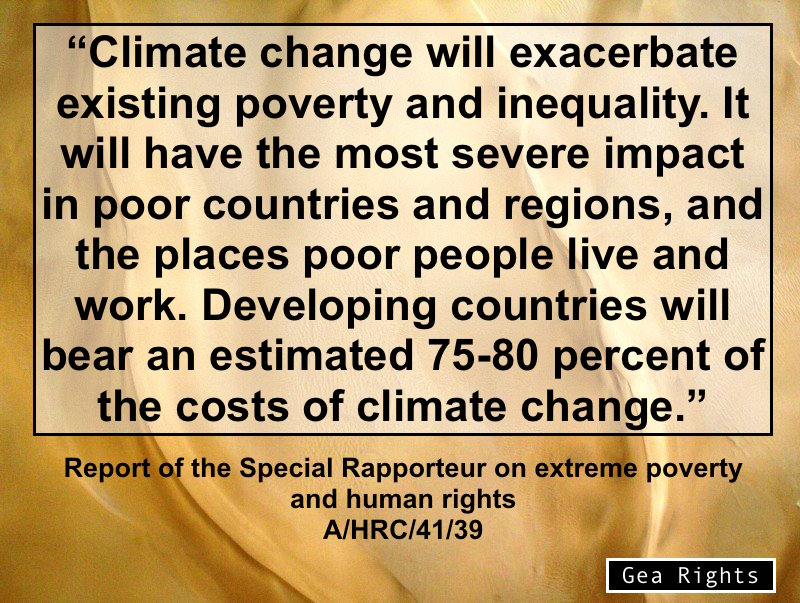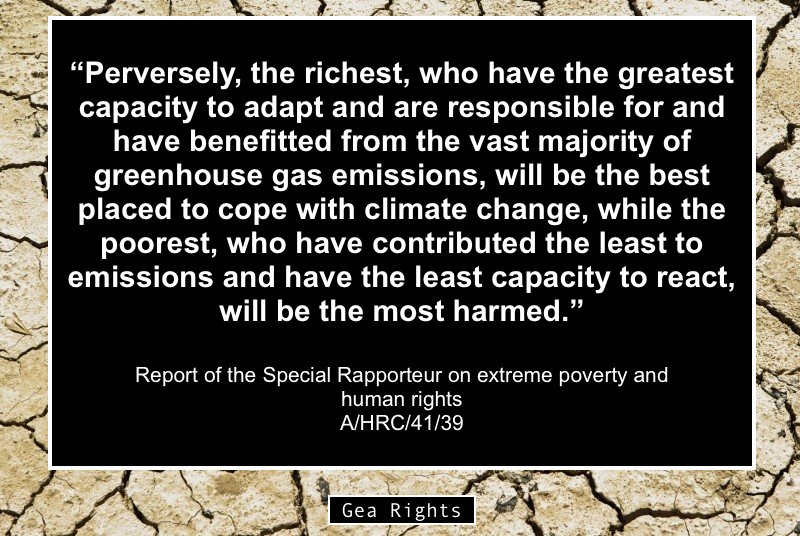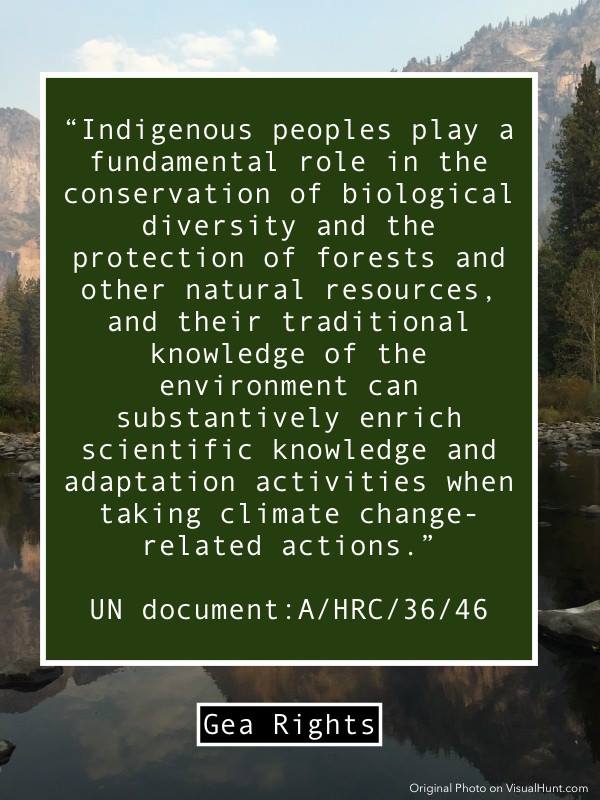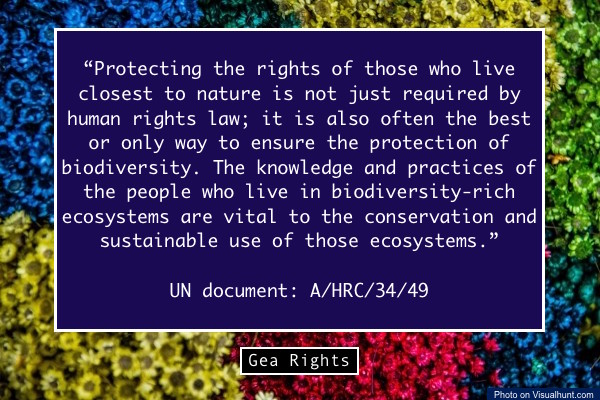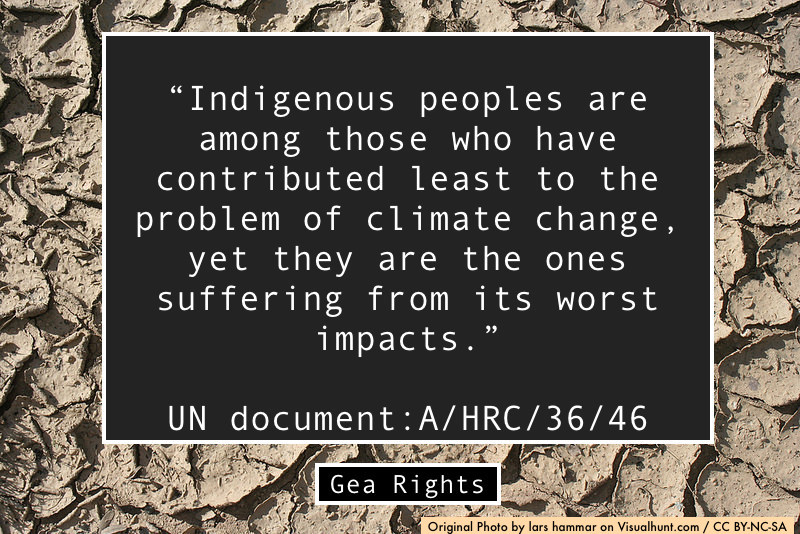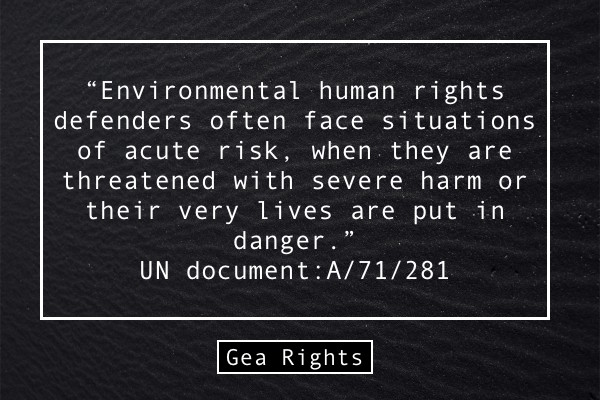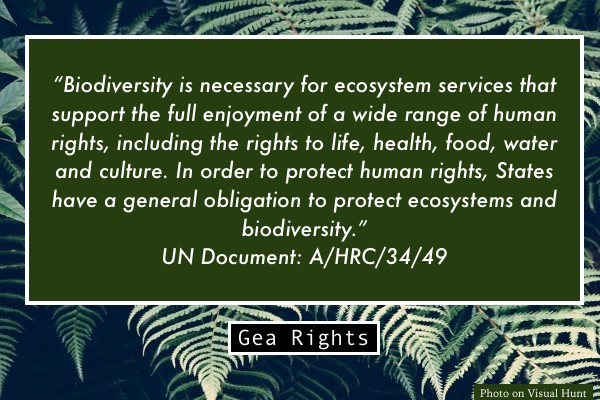On 22 April 2009 President Evo Morales Ayma, first Indigenous president of the Plurinational State of Bolivia, requested the UN General Assembly to develop a Universal Declaration of the Rights of Mother Earth. In the same year, the UN Programme “Harmony with Nature” was initiated under Bolivia’s impulse, in order to create a non- anthropocentric relationship with Nature.
In 2010, during the World People’s Conference on Climate Change and the Rights of Mother Earth in Cochabamba, Bolivia, a draft of the Universal Declaration of the Rights of Mother Earth was created, whose content is similar to that of Bolivian Law 071/2010. Endorsed by several NGO’s, civil society groups and Indigenous peoples, the declaration has not been adopted yet by the UN General Assembly.
The Declaration expresses the relationship that indigenous peoples have with nature, or Pachamama, as pointed out in the study prepared by Carlos Mamami and Bartolomé Clavero.
The study underlines that this relationship is characterized by a sacred vision of the Earth, or Pachamama in the Quechua language, which means fertile, fruitful Mother.
The indigenous peoples’ culture of reverence for the Earth was considered idolatrous by the colonizers, who made every effort to eradicate it.
As pointed out in the study:
“The current system of environmental management has failed to prevent the deterioration or destruction of natural communities and ecosystems. Protection and conservation efforts are failing because they focus on the adverse impact on the environment without addressing their causes. Natural communities and ecosystems are treated as private or public property. Mankind does not see itself as their guardian or beneficiary. Practically all non-human elements on Earth are legally considered as “natural resources” to be exploited by humankind or, more precisely, by corporations that emphasize maximizing profits for their shareholders and only engage in responsible social behaviour as regards nature and humankind as an afterthought.” (C. Mamami, B. Clavero, Study on the need to recognize and respect the rights of Mother Earth)
In this context, some countries adopted specific provisions in their constitutions or national laws regarding the recognition of the rights of Mother Earth.
In the Declaration, Mother Earth is described as
“indivisible, self-regulating community of interrelated beings each of whom is defined by its relationships within this community and with the Universe as a whole”.
The over-exploitation and destruction of Mother Earth and other beings is considered harmful to humans’ inner wellbeing and offensive to the faiths, traditions and indigenous cultures for whom Mother Earth is considered as sacred.
The healing of the damage caused by humans and the transmission of values, traditions and institutions supporting the flourish of mother Earth is considered as a responsibility towards future generations.
The Declaration affirms the importance to entrust to the rule of law the fundamental freedoms and rights of Mother Earth and of all beings.
“These fundamental rights, freedoms and duties arise from the same source as existence and are inherent to all beings, consequently they are inalienable, cannot be abolished by law, and are not affected by the political, jurisdictional or international status of the country or territory within which a being exists”.
The Declaration states that just as human beings have human rights, all other beings also have rights which are specific to their species or kind and appropriate for their role and function within the communities in which they exist. The rights of each being are limited by the rights of other beings, and any conflict between their rights must be resolved in a way that maintains the integrity, balance and health of Mother Earth.
The fundamental right of Mother Earth is to exist, to persist and to continue the vital cycles, structures, functions and processes that sustain all beings.
The fundamental rights and freedoms of all beings are identified in:
(a) the right to exist;
(b) the right to habitat or a place to be;
(c) the right to participate in accordance with its nature in the ever-renewing processes of Mother Earth;
(d) the right to maintain its identity and integrity as a distinct, self-regulating being;
(e) the right to be free from pollution, genetic contamination and human modifications of its structure or functioning that threaten its integrity or healthy functioning; and
(f) the freedom to relate to other beings and to participate in communities of beings in accordance with its nature.
The freedom of animals from torture, cruel treatment or punishment by humans is affirmed. Every being has the right to be recognized as a subject before the law and to an effective remedy against human violations and attacks of the rights and freedoms recognized by the Declaration. According to it, human beings have rights and duties aimed at its enforcement.
In particular, they have to establish values, institutions and systems that “prevent humans from causing harmful disruptions of vital ecological cycles, processes and balances, and from compromising the genetic viability and continued survival of other species” and to ensure that the damages are “rectified where possible and that those responsible are held accountable for restoring the integrity and healthy functioning of affected communities”.
Education plays a fundamental role in the development of a new culture that
“promotes a love of Mother Earth, compassion, understanding, tolerance and affection among all humans and between humans and other beings, and the observance of the fundamental freedoms, rights and duties in this Declaration”.
This proposal of Declaration, which has not been adopted yet by the United Nations, would lead to a change of epochal perspective. It would allow the passage from the anthropocentric view, which involves the prevalence of the human being and the implicit consideration of the non-human only in terms of usability, to a biocentric view which valorizes life itself.
The cultural substrate of this approach must be found in the Indigenous cosmovision, that has led to the recognition of the rights of Nature in a growing number of domestic legal systems. The recognition of the rights of Nature not only represents a legal innovation and ecological revolution, but also the affirmation of the Indigenous knowledge and worldview, that for centuries has been condemned to silence and even annihilation. The emersion of Indigenous peoples as political actors in their ancestral lands has given a decisive impulse to this paradigmatic change, while inspiring people worldwide with their continuous effort to protect their ancestral lands.
This vision, in fact, is upheld by social movements, academics and NGOs, which promote the change through various activities, such as meetings, forums and petitions. See the websites of some of the NGO’s and groups devoted to the promotion of the Declaration:
IUCN https://www.iucn.org/content/draft-universal-declaration-rights-mother-earth; https://therightsofnature.org/universal-declaration/,
Rights of Mother Earth https://www.rightsofmotherearth.com;
Earth Law Center https://sustainabledevelopment.un.org/content/documents/24861Earth_Law_Center.pdf;
Intercontinental cry https://intercontinentalcry.org/the-sami-parliament-endorses-the-universal-declaration-of-the-rights-of-mother-earth/,
Rights of Nature & Mother Earth https://www.ienearth.org/wp-content/uploads/2017/11/RONME-RightsBasedLaw-final-1.pdf, (all accessed 2 June 2020)
In June 2016 The First International Forum for the Rights of Mother Earth was held in Mexico City, where the Law of Protection of the Earth was adopted in 2013. The International Forum brought together legislators, scientists, philosophers, ecologists, artists, keepers of ancient traditions, social and spiritual leaders, in order to define actions that promote social awareness on the importance of legislating the rights of Mother Earth.
In April 2017 the Interactive Dialogue of the General Assembly on Harmony with Nature was focused on the theme of Earth Jurisprudence.
As reported by the Un Document A/71/266:
“Earth jurisprudence recognizes the Earth as the source of natural laws that govern life. It provides a cohesive framework that underpins many disciplines, weaving them together to create a more effective, holistic governance approach, reflecting the integrated nature of the world in which we live. Worldwide, indigenous peoples’ philosophies, spiritualities and traditional forms of knowledge express the understanding that human governance systems must be derived from the laws of the Earth and be in compliance with them.
Earth jurisprudence is interdisciplinary, identifying basic values that should govern economics, the physical sciences, laws and, ultimately, the contours of a holistic orientation in all disciplines. By expanding philosophical inquiry into Earth jurisprudence we can develop responsible environmental ethics and deepen our understanding of how being in harmony with Nature brings true meaningfulness and fulfilment to our lives.
Earth jurisprudence implies wholeness, and a complex and deeply interdependent life-support network that rejects the logic that gives priority to the “part” as distinct from the whole, whether it is the individual versus the community or the State versus the world. An Earth-centred model can be imagined as a culture of partnership wherein the central values are equity, cooperation, dialogue, inclusion, comprehension, agreement, respect and co-inspiration, illustrating how Earth jurisprudence can reshape prevailing models.”
(Photo on Visual Hunt)
